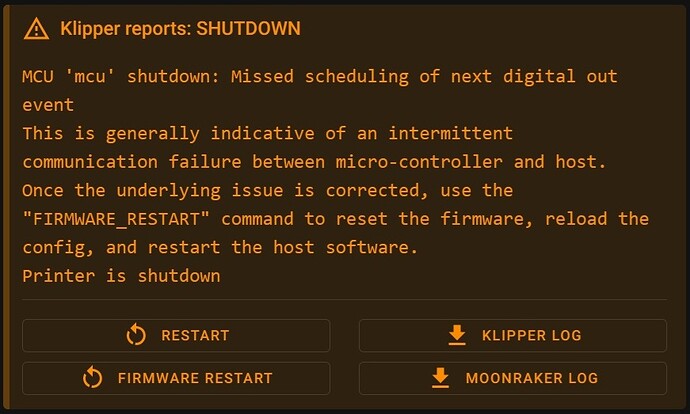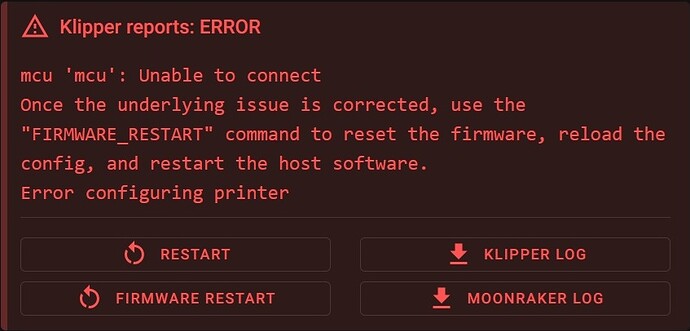Basic Information:
Printer Model: Highly customized Anycubic Chiron
MCU / Printerboard: BTT Manta M8P v2(mcu), BTT EBB42 v1.2 (EBB_X, EBB_Y, EBB_E)
Host / SBC: BTT CB2
klippy.log (9.9 MB)
The printer is a testbed printer. The hardware and config changes frequently, but the CAN network failures have persisted in every configuration since installing the M8P/CB2. I am using the M8P as the CAN adapter and do not have a separate CAN board.
The CAN network will randomly fail. I get a connection failure from one of the devices on the CAN, usually the standard timeout failure. The error will usually come from the main “mcu” MCU not the “EBB_X”, “EBB_Y”, or “EBB_E” device, although it can come from any of them. The error has also occurred when there were no EBB42 boards connected and the only MCU was the M8P itself. No matter which MCU generateds the initial error, when the firmware is restated I get a connection error on the “mcu” MCU. As this MCU is physically on the same board as the CAN adapter this should be impossible. The problem can only be corrected by a power cycle. None of the reboot options correct this error. When there is a physical connection issue on the CAN network, reconnecting the device and performing a firmware restart will correct the error.
…
Update:
The error happened again. The initial shutdown message is ”MCU ‘mcu’ shutdown: Missed scheduling of next digital out event”
I clicked the “Firmware Restart” button.
After the system restarts it goes to a waiting message.
After a couple of minutes, it gives another CAN error message saying unable to connect to MCU ‘mcu.
The error persists after every reboot until the system is hard power cycled.
The Klippy log is too big (38MB). If someone can give me instructions I’m more than happy to alter/upload it another way. The new klippy log was downloaded after a succesful reboot from a hard power cycle of the system, a failed full reboot from the web UI, and a failed firmware reboot from the error message UI.
Since the error I have installed can-utils and will try to set up it’s monitoring features, but I am beyond my depth in this. Any help or troubleshooting guidance would be appreciated.
Here is the initial shutdown error from the log file:
Receive: 73 825805.557532 825805.557211 11: seq: 17, clock clock=1286237664
Receive: 74 825805.601452 825805.557211 14: seq: 17, analog_in_state oid=7 next_clock=1307800642 value=9510
Receive: 75 825805.901528 825805.653788 14: seq: 18, analog_in_state oid=7 next_clock=1327000642 value=9513
Receive: 76 825806.044960 825806.040861 18: seq: 1a, tmcuart_response oid=2 read=b’\n\xfa\xef-\x808\x02\x08 \xbb’
Receive: 77 825806.051317 825806.047211 18: seq: 1b, tmcuart_response oid=2 read=b’\n\xfa/ \x80\x00\x02\x08\xa0\x89’
Receive: 78 825806.201467 825806.118678 14: seq: 18, analog_in_state oid=7 next_clock=1346200642 value=9511
Receive: 79 825806.224706 825806.224220 11: seq: 19, canbus_status rx_error=0 tx_error=0 tx_retries=0 canbus_bus_state=active
Receive: 80 825806.501526 825806.224220 14: seq: 19, analog_in_state oid=7 next_clock=1365400642 value=9512
Receive: 81 825806.541002 825806.540623 11: seq: 1a, clock clock=1349172257
Receive: 82 825806.801469 825806.540623 14: seq: 1a, analog_in_state oid=7 next_clock=1384600642 value=9514
Receive: 83 825807.045758 825807.041600 18: seq: 1c, tmcuart_response oid=2 read=b’\n\xfa\xef-\x808\x02\x08 \xbb’
Receive: 84 825807.052206 825807.048060 18: seq: 1d, tmcuart_response oid=2 read=b’\n\xfa/ \x80\x00\x02\x08\xa0\x89’
Receive: 85 825807.101518 825807.048060 14: seq: 1d, analog_in_state oid=7 next_clock=1403800642 value=9512
Receive: 86 825807.227701 825807.227248 11: seq: 1f, canbus_status rx_error=0 tx_error=0 tx_retries=0 canbus_bus_state=active
Receive: 87 825807.401472 0.000000 14: seq: 16, analog_in_state oid=7 next_clock=1423000642 value=9515
Receive: 88 825807.701575 0.000000 14: seq: 16, analog_in_state oid=7 next_clock=1442200642 value=9514
Receive: 89 825808.001487 0.000000 14: seq: 16, analog_in_state oid=7 next_clock=1461400642 value=9513
Receive: 90 825808.301727 0.000000 14: seq: 16, analog_in_state oid=7 next_clock=1480600642 value=9511
Receive: 91 825808.601486 0.000000 14: seq: 16, analog_in_state oid=7 next_clock=1499800642 value=9514
Receive: 92 825808.901593 0.000000 14: seq: 16, analog_in_state oid=7 next_clock=1519000642 value=9512
Receive: 93 825809.201537 0.000000 14: seq: 16, analog_in_state oid=7 next_clock=1538200642 value=9512
Receive: 94 825809.501699 0.000000 14: seq: 16, analog_in_state oid=7 next_clock=1557400642 value=9514
Receive: 95 825809.801659 0.000000 14: seq: 16, analog_in_state oid=7 next_clock=1576600642 value=9513
Receive: 96 825810.101791 0.000000 14: seq: 16, analog_in_state oid=7 next_clock=1595800642 value=9512
Receive: 97 825810.101837 0.000000 15: seq: 16, stats count=427 sum=491811 sumsq=5264979
Receive: 98 825810.401642 0.000000 14: seq: 16, analog_in_state oid=7 next_clock=1615000642 value=9513
Receive: 99 825810.402734 0.000000 12: seq: 16, shutdown clock=1596312989 static_string_id=Missed scheduling of next digital out event
Stats 825810.5: gcodein=0 canstat_mcu: bus_state=unknown rx_error=0 tx_error=0 tx_retries=0 mcu: mcu_awake=0.012 mcu_task_avg=0.000002 mcu_task_stddev=0.000001 bytes_write=269823397 bytes_read=58277823 bytes_retransmit=1281 bytes_invalid=0 send_seq=5332751 receive_seq=5332748 retransmit_seq=5332751 srtt=0.001 rttvar=0.001 rto=3.200 ready_bytes=635 upcoming_bytes=6119 freq=399992819 canstat_EBB42_E: bus_state=unknown rx_error=0 tx_error=0 tx_retries=0 EBB42_E: mcu_awake=0.008 mcu_task_avg=0.000018 mcu_task_stddev=0.000021 bytes_write=70657764 bytes_read=23606417 bytes_retransmit=1199 bytes_invalid=0 send_seq=1658089 receive_seq=1658086 retransmit_seq=1658089 srtt=0.001 rttvar=0.001 rto=3.200 ready_bytes=0 upcoming_bytes=1551 freq=63999150 adj=64000630 heater_bed: target=100 temp=100.9 pwm=0.000 sysload=0.88 cputime=33944.513 memavail=1588880 print_time=157127.733 buffer_time=1.633 print_stall=0 extruder: target=245 temp=245.1 pwm=0.000
Timeout with MCU ‘mcu’ (eventtime=825811.519333)
Timeout with MCU ‘EBB42_E’ (eventtime=825811.519333)



